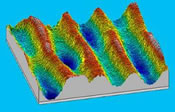| |
|
Today
11
a.m.
AFRD
Progress Towards A Solid State Quantum Computer
Steven Prawer, U. of Melbourne
Bldg. 71-264
ALS
Adaptive Engineering of Coherent Soft X-Rays
Thomas Pfeifer, U. of Wuerzburg
Bldg. 6-2202
Noon
Employee Activities Assoc.
Yoga Class with Keith Olson
Bldg. 70A-3377
4
p.m.
Life Sciences
TGFb Signaling on Cytostasis and Metastasis
Joan Massague, Sloan Kettering Cancer Center
Bldg. 66 Auditorium
Tomorrow
Noon
Employee Activities Assoc.
Yoga Class with Maya Smith
Bldg. 70A-3377
4 p.m.
Life Sciences
Testing a 3D-Structure Based Hypothesis for the Transport
of IgG Across Epithelia by the Neonatal Fc Receptor
Pamela Bjorkman, Caltech
Bldg 66 Auditorium
|
|
| |
 |
| |
Morning Additions: Pancakes(2), Eggs(2),
Hash Browns and Bacon (2)
Market Carvery: Fried Teriyaki Pork
Ribs with Jasmine Rice and Bok Choy
Fresh
Grille: Salisbury Steak with Fries and Vegetable
Menutainment:
Veal Fritter with Mushroom and Wine Sauce
|
|
B'fast: |
6:30
a.m. - 9:30 a.m. |
| Lunch: |
11
a.m. - 1:30 p.m. |
Full
menu
|
|
|
|
 |
| |
 |

Maritz
Sold; No Change
In Lab Travel Process
Carlson
Wagonlit Travel (CWT) has received regulatory approval
to acquire Maritz Corporate Travel (MCT). There will
be no changes to the agency staff handling Berkeley
Lab reservations, and the phone numbers remain the same.
However, effective today, Lab employees will begin to
see and hear the CWT brand as they interface with the
contracted agency. E-mail communication will now originate
from "@carlson.com." Logos on all materials,
both printed and electronic, are being converted to
reflect the CWT brand over the next few weeks. For questions,
call the Travel Office at x4500.
Lab
Staff to Give Talks
On Peta-Scalable Codes
Osni
Marques and Tony Drummond of the Scientific
Computing Group and Kathy Yelick of the Future
Technologies Group in the Computational Research Division
are among the speakers at a workshop today and tomorrow
on "New
Methods for Developing Peta-Scalable Codes"
being held at the Pittsburgh Supercomputing Center.
The workshop, co-sponsored by the Department of Energy,
will focus on languages and frameworks for developing
codes that will efficiently utilize thousands of processors.
Facilities Quarterly
Seeks Reader Input
The
Facilities Department would like to know what you think
about its newsletter, Facilities Quarterly. The
January/April 2004 issue is now on-line here,
and the quarterly’s web site includes a link to
a simple readership
survey. The current issue includes stories on various
facilities projects, including the Molecular Foundry
construction, Site-wide Water Project, and the Bevatron
EPB hall, plus features on facilities safety “fashions”
and the Rosas’ Christmas.

|
 |
|

|
|
|
 |
|
|
|
|
|
|
| |
|
 |
|
|
|
|
|
Digital
cylinder scan |
|
|
|
Physicists
Find Method
To Improve Audio
By
the Associated Press
Two physicists have discovered a way to digitally map
old, archived audio recordings and reconstruct the sound.
Four years after hearing a radio report on the challenge
of preserving aging audio recordings, particle physicist
Carl Haber's newfound method of rescuing the
classics is music to archivists' ears. Haber and a fellow
Berkeley Lab physicist Vitaliy Fadeyev have found
a way to digitally map the grooves in warped or damaged
shellac records and wax cylinders — and play them back
using a sort of virtual needle. To do so, they use the
same optical scanning method — powered by a microscope
and computer technology — that physicists employ for
measuring the journeys of subatomic particles. Full
story.

Latest
Issue of ‘Beat’
Has Warming Package
|
|
|
|
 |
 |
|
|
| SOLO
probe |
|
|
|
Research
that addresses global warming – and carbon sequestration
underground, in oceans and on land – is included
in a special section of the lastest issue of Berkeley
Lab’s web magazine Science Beat. It also features
stories on chromosome-building protein structures, energy-saving
windows, garbage-eating bioreactors, and pinpoint LED’s.
For all this and more, go here.

Technique
Plucks Genes
From Pathogen Genomes
By
Robert Sanders
A
quick new technique able to identify genes that evolve
rapidly as well as those that change slowly already has
pinpointed new targets for researchers developing drugs
against tuberculosis and malaria, and it could do the
same for other infectious diseases, according to a paper
in the April 29 issue of Nature. The technique
was developed by a research team that included co-author
and graduate student Hunter B. Fraser from Berkeley Lab
life scientist Michael Eisen’s lab. Read
the UC Berkeley news release here.
|
 |
|
|
|
| |
|

